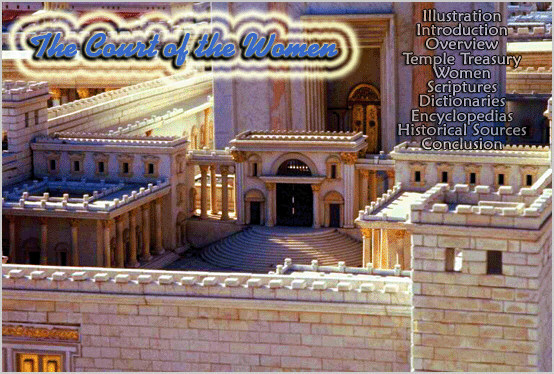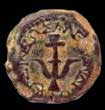The Court of the Women in the Temple
Overview

Overview of
The Court of the Women in Israel
 If
you were to approach the Temple in Jerusalem in the first century A.D. you would
pass through the eastern gate where Jesus made His triumphal entry. Then you
would come to the Court of the Gentiles which was a large court paved with
stones of various colors. It was open to all comers including the cattle-dealers
and the money-changers who desecrated the Temple. This court was also called the
Outer Court, the Lower Court, and the rabbi�s usually called it "the Mountain of
the Lord�s House." All around the Temple proper was a 9 foot high terrace with
stairs which was higher than the Court of the Gentiles. It was surrounded by a 5
foot high wall which was designed to keep out the gentiles. There was also
pillars in the wall at various distances (the Soreg) with inscriptions in Latin,
Greek, and Hebrew, warning all gentiles to come no further under penalty of
death.
If
you were to approach the Temple in Jerusalem in the first century A.D. you would
pass through the eastern gate where Jesus made His triumphal entry. Then you
would come to the Court of the Gentiles which was a large court paved with
stones of various colors. It was open to all comers including the cattle-dealers
and the money-changers who desecrated the Temple. This court was also called the
Outer Court, the Lower Court, and the rabbi�s usually called it "the Mountain of
the Lord�s House." All around the Temple proper was a 9 foot high terrace with
stairs which was higher than the Court of the Gentiles. It was surrounded by a 5
foot high wall which was designed to keep out the gentiles. There was also
pillars in the wall at various distances (the Soreg) with inscriptions in Latin,
Greek, and Hebrew, warning all gentiles to come no further under penalty of
death.
Going beyond the
Court of the Gentiles and at the top of the terrace there was a platform for
about 15 feet and then there was another wall. On the east side stood the
magnificent 60 foot wide "Gate Beautiful" mentioned in Acts 3:2,10. It was also
referred to as the "Gate Susan" because it contained a beautifully sculptured
relief of the city of Susa. During the time of the morning and evening
sacrifices this great entrance was the place of public worship.
Entering through
the Susan Gate you would come to a large court called "the Court of the Women"
not because there were only women there but because women could not go beyond
it. There were smaller courts with columns in the four corners of the court.
According to the
Mishnah (Middoth 2,5) the Women's Court was was just over 200 feet square
between bounding lines. Each court on the outside was 60 feet square.
In front of these
columns were the eleven treasure chests of the Temple for the voluntary
offerings of money, and there were also two at the Gate of Susan, for the
half-shekel tax. Jesus was sitting �opposite the treasury' when he saw the widow
put into one of the containers the two copper coins which were all that she had
(Mark 12:41-44; Lk 21:1-2).
Mark 12:41-44 "Now Jesus sat opposite the treasury and saw how the people put
money into the treasury. And many who were rich put in much. Then one poor widow
came and threw in two mites, which make a quadrans. So He called His disciples
to Himself and said to them, "Assuredly, I say to you that this poor widow has
put in more than all those who have given to the treasury; for they all put in
out of their abundance, but she out of her poverty put in all that she had, her
whole livelihood."
It was near these
treasure chests that the man healed of his blindness came up to Jesus in John
8:20 and worshipped Him.
Continuing eastward
there was a magnificent circular staircase and the Nicanor Gate. Entering
through the gate there was a narrow hall filled with beautiful cloistered
columns called "Court of the Israelites" and it was also through a wall and up a
flight of stairs. The Court of the Israelites surrounded the "Court of the
Priests" which was where the altar of sacrifice was. The women could only glance
over a balcony from the Court of the Women to see the ceremonies inside the
Inner Court (According to Middoth).

The Women's Court in the
Temple in Jerusalem

Mark 12:41-44 "Now Jesus sat opposite the treasury and saw how the people
put money into the treasury. And many who were rich put in much. Then one
poor widow came and threw in two mites, which make a quadrans. So He called
His disciples to Himself and said to them, "Assuredly, I say to you that
this poor widow has put in more than all those who have given to the
treasury; for they all put in out of their abundance, but she out of her
poverty put in all that she had, her whole livelihood."
The
Jerusalem Temple
 If you were to approach the Temple in
Jerusalem in the first century A.D. you would pass through the eastern gate
where Jesus made His triumphal entry. Then you would come to the Court of
the Gentiles which was a large court paved with stones of various colors. It
was open to all comers including the cattle-dealers and the money-changers
who desecrated the Temple. This court was also called the Outer Court, the
Lower Court, and the rabbi�s usually called it "the Mountain of the Lord�s
House." All around the Temple proper was a 9 foot high terrace with stairs
which was higher than the Court of the Gentiles. It was surrounded by a 5
foot high wall which was designed to keep out the gentiles. There was also
pillars in the wall at various distances (the Soreg) with inscriptions in
Latin, Greek, and Hebrew, warning all gentiles to come no further under
penalty of death.
If you were to approach the Temple in
Jerusalem in the first century A.D. you would pass through the eastern gate
where Jesus made His triumphal entry. Then you would come to the Court of
the Gentiles which was a large court paved with stones of various colors. It
was open to all comers including the cattle-dealers and the money-changers
who desecrated the Temple. This court was also called the Outer Court, the
Lower Court, and the rabbi�s usually called it "the Mountain of the Lord�s
House." All around the Temple proper was a 9 foot high terrace with stairs
which was higher than the Court of the Gentiles. It was surrounded by a 5
foot high wall which was designed to keep out the gentiles. There was also
pillars in the wall at various distances (the Soreg) with inscriptions in
Latin, Greek, and Hebrew, warning all gentiles to come no further under
penalty of death.
Going beyond the Court of the Gentiles and at the top of the terrace there
was a platform for about 15 feet and then there was another wall. On the
east side stood the magnificent 60 foot wide "Gate Beautiful" mentioned in
Acts 3:2,10. It was also referred to as the "Gate Susan" because it
contained a beautifully sculptured relief of the city of Susa. During the
time of the morning and evening sacrifices this great entrance was the place
of public worship.
Entering through the Susan Gate you would come to a large court called "the
Court of the Women" not because there were only women there but because
women could not go beyond it. There were smaller courts with columns in the
four corners of the court.
According to the Mishnah (Middoth 2,5) the Women's Court was was just over
200 feet square between bounding lines. Each court on the outside was 60
feet square.
In front of these columns were the eleven treasure chests of the Temple for
the voluntary offerings of money, and there were also two at the Gate of
Susan, for the half-shekel tax. Jesus was sitting �opposite the treasury'
when he saw the widow put into one of the containers the two copper coins
which were all that she had (Mark 12:41-44; Lk 21:1-2).
It was near these treasure chests that the man healed of his blindness came
up to Jesus in John 8:20 and worshipped Him.
Continuing eastward there was a magnificent circular staircase and the
Nicanor Gate. Entering through the gate there was a narrow hall filled with
beautiful cloistered columns called "Court of the Israelites" and it was
also through a wall and up a flight of stairs. The Court of the Israelites
surrounded the "Court of the Priests" which was where the altar of sacrifice
was. The women could only glance over a balcony from the Court of the Women
to see the ceremonies inside the Inner Court (According to Middoth).
Illustration
Introduction
Overview
Chel
Beautiful Gate
Nicanor Gate
Circular Steps
Levite Choirs
Oil of Yah Court
Nazarite Court
Leper's Chamber Court
Woodshed Court
Colonnades
Balconies
The Temple Treasury
Women
Scriptures
Dictionaries
Encyclopedias
Historical Sources
Heart Message
An Old
Woman - A Heart Message

Related Content